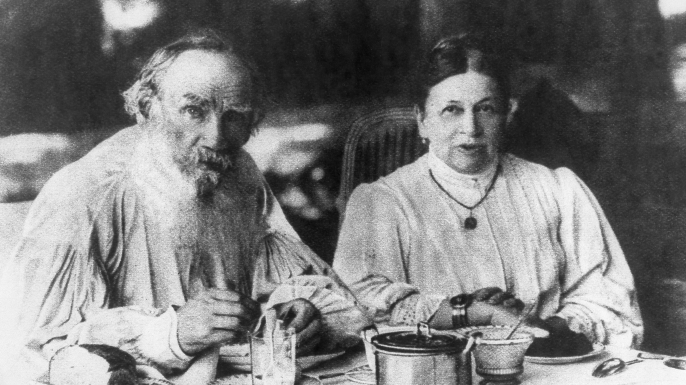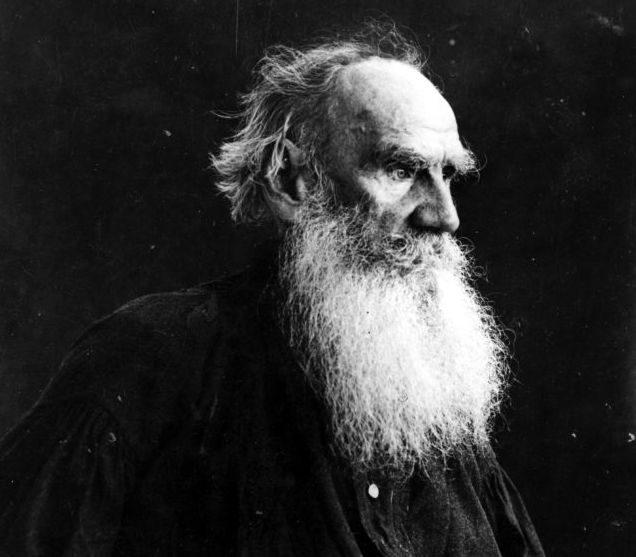Count Lev Nikolayevich Tolstoy (Leo Tolstoy) was a renowned Russian author and one of the greatest authors of all time. He is best known for his two novels War and Peace (1869) and Anna Karenina (1877). Tolstoy also wrote dozens of short stories and novellas, along with a semi-autobiographical trilogy that he achieved literary success with in the 1850s.
On September 9, 1828, Lev Nikolayevich Tolstoy was born at his family’s estate, Yasnaya Polyana, near Tula, Russia. The Tolstoys came from a long line of Russian nobility, and he was the fourth of Count Nikolai Ilyich Tolstoy and Countess Mariya Tolstaya’s five children. His parents died when he was young, so he and his siblings grew up with other relatives.
Tolstoy began to study law and oriental languages in 1844 at Kazan University. He ended up leaving in the middle of his studies though, as his teachers said he was “both unable and unwilling to learn.” So, he returned home to Yasnaya Polyana but began spending much of his time in Moscow and Saint Petersburg. He racked up heavy debts from gambling in 1851, so him and his brother went to join the army in Caucasus. Tolstoy also took up writing around this same time.
Along with joining the army, Tolstoy also travelled Europe twice. The first trip in 1857 and the second from 1860-61. While he was in Paros in 1857, he witnessed a public execution. The event was very traumatizing for him and stayed with him for the rest of his life. When he read the Tirukkural in German, his ideas of non-violence (Ahimsa) were strengthened. During the second European trip, his political and literary development were even further strengthened when he met Victor Hugo, the acclaimed French author. Tolstoy praised the author for his talents after reading his latest novel, Les Misérables. In Tolstoy’s War and Peace, Hugo’s influence is shown by the way he wrote battle scenes. Tolstoy also met and was influenced by Pierre-Joseph Proudhon, a French anarchist. Proudhon was about to publish La Guerre et la Paix, which means War and Peace in french. Tolstoy borrowed the title for his own future work.
Upon his return to Yasnaya Polyana, Tolstoy founded thirteen schools for the children of peasants in Russia after discussing education with Proudhon. His experiments with education did not, however, last long. This was in part due to the the Tsarist secret police harassing him.
Tolstoy married eighteen year old Countess Sophia Andreyevna Behrs on September 23, 1862 in Moscow. Her family and friends called her Sonya and she was sixteen years younger than Tolstoy and her father was a court physician. The couple had thirteen children, eight of which survived into adulthood: Count Sergei Lvovich Tolstoy (1863-1947), Countess Tatyana Lvovna Tolstaya (1864-1950), Count Ilya Lvovich Tolstoy (1866-1933), Count Lev Lvovich Tolstoy (1869-1945), Countess Maria Lvovna Tolstaya (1871-1906), Count Peter Lvovich Tolstoy (1872-73), Count Nikolai Lvovich Tolstoy (1874-75), Countess Varvara Lvovna Tolstaya (1875-75), Count Andrei Lvovich Tolstoy (1877-1916), Count Michael Lvovich Tolstoy (1879-1944), Count Alexei Lvovich Tolstoy (1881-86), Countess Alexandra Lvovna Tolstaya (1884-1979), and Count Ivan Lvovich Tolstoy (1888-95).
During the early years of their marriage, they were happy and Tolstoy was given time to work on his two novels as much as possible. Sonya even acted as his secretary and financial adviser and proofread Anna Karenina and War and Peace for him. A.N. Wilson described their later life as one of the unhappiest in literary history. While his beliefs became even more radical, his relationship with Sonya deteriorated.
On November 20, 1910, eighty-two year old Leo Tolstoy. His health had been worsening and a few days before his death, he had been writing and speaking about death. Shortly before, he had separated his wife and fled their home in the middle of the night, despite it being the dead of winter. When he died, he was at Astapovo train station and had been ill with pneumonia.
Tolstoy is considered to be one of the most influential figures in Russian literature and one of the greatest authors of all time with Anna Karenina and War and Peace, along with written notable novellas like The Death of Ivan Ilyich and Hadji Murad. Famous author Virginia Woolf even once called him “the greatest of all novelists.” Many other authors of his day and more recently have praised him.
His first works were a set of semi-autobiographical novels called Childhood (1852), Boyhood (1854), and Youth (1857). The novels were about the son of a rich landowner as he slowly realized the differences between himself and the peasants. In Sevastopol Sketches (1855), which were three short stories, he recounted his time in an artillery regiment as a second lieutenant.
Tolstoy wrote The Cossacks in 1863 in an attempt to realistically portray what life was like in Russian society. This novel was about the Cossack people and their lives and how a Russian aristocrat falls in love with one of them. In 1877, Anna Karenina was published and tells a similar story of a woman committing adultery but who is trapped by society and a philosophical landowner that was similar to Tolstoy himself.
War and Peace, published in 1865 as a serial, remains to be Tolstoy’s most notable work and is considered to be one of the greatest pieces of literature ever written. It tells the story of family life, Napoleon’s headquarters, Alexander I of Russia’s court, and the battlefields of Austerlitz and Borodino. Many of the characters were based on himself and other family members and friends. Tolstoy did not consider it to be a novel though and thought it more of an epic. He believed that Anna Karenina, which he published about a decade later, was his first true novel.
After he published Anna Karenina, Tolstoy turned to more of a focus on Christian themes with his later works.




